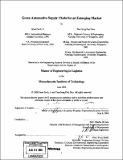Green automotive supply chain for an emerging market
Author(s)
Fisch, Gene (Gene Joseph); Neo, Tien Song Paul
DownloadFull printable version (16.01Mb)
Other Contributors
Massachusetts Institute of Technology. Engineering Systems Division.
Advisor
Charles H. Fine.
Terms of use
Metadata
Show full item recordAbstract
Green Supply Chain Management (GSCM) within the automotive industry is largely based on combining lean manufacturing with mandated supplier adoption of ISO 14001-compliant Environmental Management Systems (EMS). This approach evolved from automotive manufacturers seeking to expediently expand green practices within existing lean supply chains. However, a new automotive enterprise, without the legacy issues of an existing supply chain, has the opportunity to customize its supply chain from scratch, to comprehensively achieve both financial and green objectives. This thesis investigated a more holistic approach to creating a financially-viable green automotive supply chain for the MIT Vehicle Design Summit (VDS) - a start-up enterprise planning to enter the Indian emerging market with a new type of eco-friendly automobile. First, a hypothetical VDS supply chain was postulated by analyzing the contextual challenges of the Indian emerging economy, so as to optimize the location, supplier selection and manufacturing models within its business context. To ensure that the capital investments needed to fulfill the supply chain's green objectives do not compromise its primary purpose of value creation, a Triple Bottom Line technique called Environmental Cost Accounting was used as a managerial decision tool, which demonstrated the financial viability of GSCM for VDS. Next, green solutions for each supply chain function were identified for integration into the hypothetical supply chain. It was found that many important green solutions for an automotive supply chain like supplier selection, concurrent engineering, cascading of lean production best practices to the extended supply chain, fuel-efficient transport practices and green infrastructure design, have already been developed by various governmental and non-governmental agencies. (cont.) Also, product recovery through End-of-Life Vehicle (ELV) processing was identified as a vital green supply chain function required for closing the loop between sales and sourcing. The key issue was integrating these disparate solutions into a holistic environmental management framework for VDS to implement and sustain. This was accomplished using an IS014001-based EMS as the master plan. The developed EMS Manual is a pioneering document that leverages chain-wide participation in existing green initiatives like the Green Suppliers Network, SmartWay Transport Partnership and LEED Green Building Rating, to realize a green supply chain by ensuring continuous monitoring and improvement of the implemented initiatives.
Description
Thesis (M. Eng. in Logistics)--Massachusetts Institute of Technology, Engineering Systems Division, 2008. Includes bibliographical references (leaves 94-97).
Date issued
2008Department
Massachusetts Institute of Technology. Engineering Systems DivisionPublisher
Massachusetts Institute of Technology
Keywords
Engineering Systems Division.